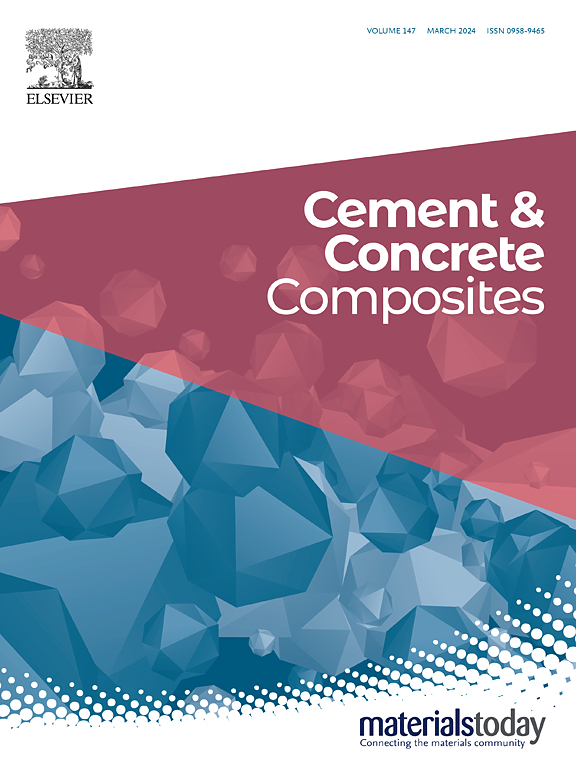硫酸盐和镁离子对石灰石煅烧粘土水泥(LC3)中氯离子扩散和相组合的影响机制
IF 13.1
1区 工程技术
Q1 CONSTRUCTION & BUILDING TECHNOLOGY
引用次数: 0
摘要
石灰石煅烧粘土水泥(LC3)是一种低碳胶凝材料,具有优异的抗氯离子渗透性能。然而,真实环境中除了氯离子之外,还富含许多有害离子,包括硫酸盐离子和镁离子,使得这些离子之间的相互作用非常复杂。本研究系统探讨了硫酸盐离子的影响以及硫酸盐和镁离子的协同作用对LC3氯离子转运性质和氯离子结合能力的影响。不同环境下的相组合、孔隙结构和微观结构特征不同。此外,采用热力学模型确定了离子浓度和类型对相组合的影响。研究结果表明,在LC3中,硫酸盐离子显著影响弗里德尔盐的稳定性,将其转化为钙矾石(Ett)。此外,硫酸盐离子可与单硫酸盐(Ms)结合或与半碳铝酸盐(Hc)/单碳铝酸盐(Mc)进行离子交换形成Ett,使孔隙结构细化,降低氯离子的扩散系数。然而,长时间暴露会导致样品膨胀,加速氯离子的扩散速率。此外,硫酸盐离子抑制氯离子扩散的持续时间与铝酸钙相的含量有关。硫酸盐和镁离子的共同攻击导致C-(A)- s - h脱钙,生成石膏和水镁石,分解弗里德尔盐和Ett,进一步降解基质,促进氯离子扩散。而降低LC3中熟料的用量,可以有效提高氯离子的结合能力,减少石膏和水镁石的生成。本文章由计算机程序翻译,如有差异,请以英文原文为准。
Insight into the mechanism of sulfate and magnesium ions on chloride diffusion and phase assemblage in limestone calcined clay cement (LC3)
Limestone calcined clay cement (LC3), a low-carbon cementitious material, has demonstrated outstanding resistance to chloride ion penetration. However, the real environment is rich in many harmful ions beyond chloride ions, including sulfate and magnesium ions, making the interactions among these ions highly complex. This study systematically explores the impact of sulfate ions and the synergistic effects of sulfate and magnesium ions on the chloride ion transport properties and chloride ions binding capacity of LC3. The characteristics of phase assemblage, pore structure, and microstructure vary differently under different environments. Furthermore, a thermodynamic model was employed to determine the impact of ion concentration and type on the phase assemblage. The findings suggest that within LC3, sulfate ions significantly affect Friedel's salt stability, converting it into ettringite (Ett). In addition, sulfate ions can combine with monosulfate (Ms) or undergo ion exchange with hemicarboaluminate (Hc)/monocarboaluminate (Mc) to form Ett, refining the pore structure and reducing the diffusion coefficient of chloride ions. However, prolonged exposure leads to sample expansion, accelerating the diffusion rate of chloride ions. Furthermore, the duration of sulfate ion inhibition on chloride diffusion is associated with the content of calcium aluminate phases. The combined attack of sulfate and magnesium ions lead to C-(A)-S-H decalcification, generation of gypsum and brucite, and decomposition of Friedel's salt and Ett, which further degrades matrix and promotes chloride ion diffusion. However, reducing the clinker amount in LC3 effectively enhances chloride binding capacity and reduces gypsum and brucite formation.
求助全文
通过发布文献求助,成功后即可免费获取论文全文。
去求助
来源期刊

Cement & concrete composites
工程技术-材料科学:复合
CiteScore
18.70
自引率
11.40%
发文量
459
审稿时长
65 days
期刊介绍:
Cement & concrete composites focuses on advancements in cement-concrete composite technology and the production, use, and performance of cement-based construction materials. It covers a wide range of materials, including fiber-reinforced composites, polymer composites, ferrocement, and those incorporating special aggregates or waste materials. Major themes include microstructure, material properties, testing, durability, mechanics, modeling, design, fabrication, and practical applications. The journal welcomes papers on structural behavior, field studies, repair and maintenance, serviceability, and sustainability. It aims to enhance understanding, provide a platform for unconventional materials, promote low-cost energy-saving materials, and bridge the gap between materials science, engineering, and construction. Special issues on emerging topics are also published to encourage collaboration between materials scientists, engineers, designers, and fabricators.
 求助内容:
求助内容: 应助结果提醒方式:
应助结果提醒方式:


